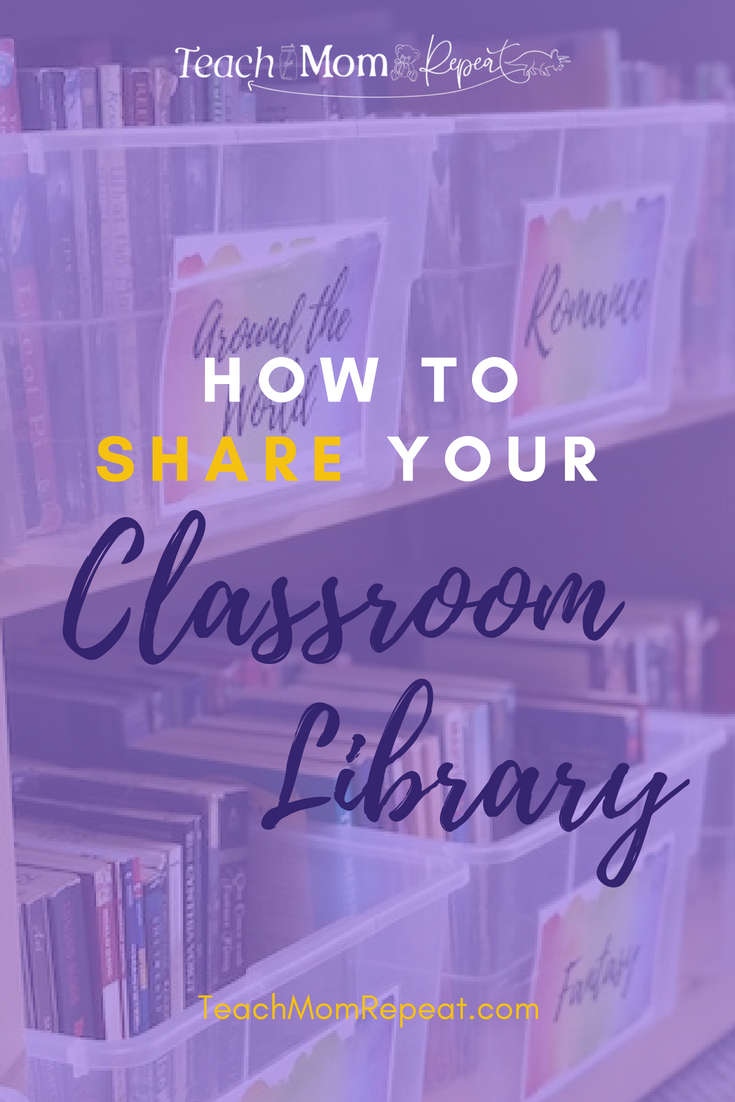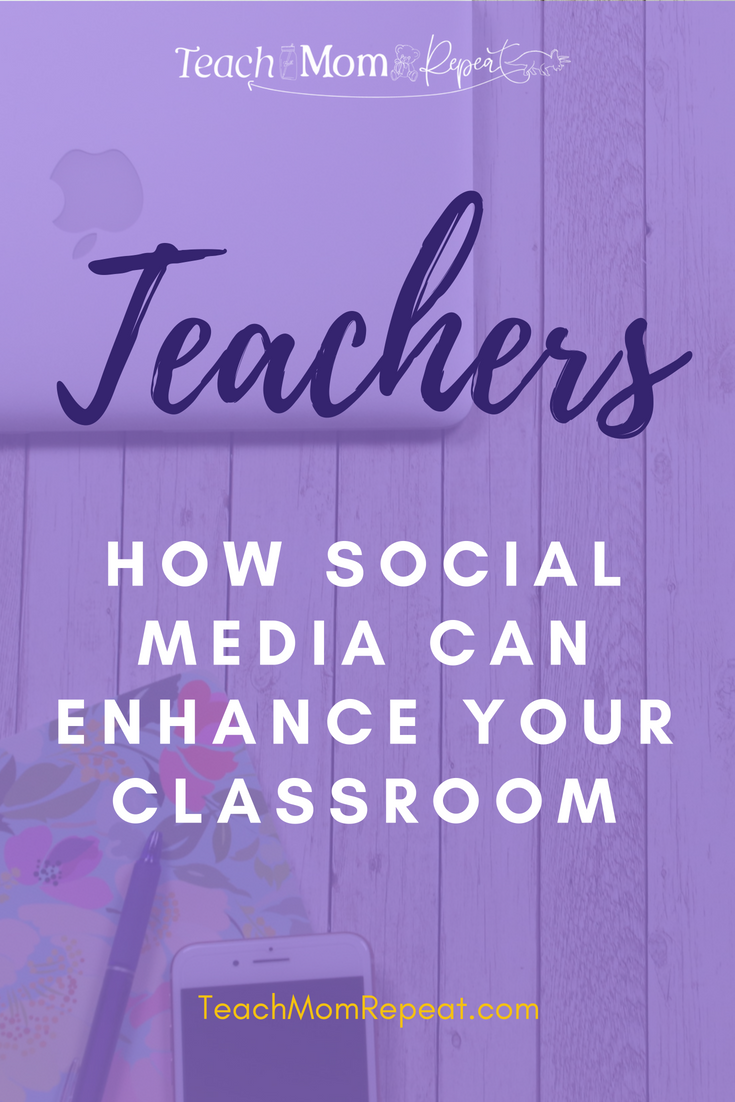
by Carly Black | Aug 10, 2017 | Classroom Solutions, Lesson Plans, Library, Teacher Solutions
This summer my classroom library got a makeover. Mostly because it gained another 1,000 books! I’ve taken over the classroom of a retired teacher who left her beloved library behind for my students to continue to enjoy. I’m beyond grateful for this kind of gifting, and I’m having a fabulous time getting to know some of the new books. I can’t wait to introduce them all to my students.

Some of the links found in this post are affiliates. This means if you make a purchase after clicking through we will receive a small compensation at no extra cost to you. Thank you in advance for your support and please know that we only endorse products we use and love.
3 Engaging Ideas to Share Your Classroom Library
Let me share a few ways I’ve discovered to help share all the different books living in my classroom library.
Show and Tell Book Style:
This is exactly what it sounds like, ask students to find a book in your library that they have read and enjoyed. Give students a few minutes to think about or write what they remember liking about the book and two highlights from the story. Students can then share them with the whole class or in small groups for a less intimidating audience.
Sail the Stacks:
This activity takes a little set up and works well when desks are in small groups. Start by creating stacks of 8-12 books of the same genre. Choose books that tend to be popular within the genre and are great representations of the genre. You could add genre labels to each table, or simply place a sticky note on the stack. Write on the board or announce, “If you were shipwrecked on an island and found a crate of books that contained only one genre of books what genre would you want it to be?” Have them “visit” that island and allow them a few minutes to talk about the stack. Add a “rowboat” and allow them to travel to a different island.
Speed Booking:
It’s similar to the concept of Speed dating. I always like to share this funny eHarmony commercial to introduce the activity. This activity also takes some set up. I have tried this with several different desk formations, but a circle works best.
We start by talking about the things that “attract” us to books. That leads to a discussion about how we make the decision to read the book. We write the list of options on the board. The list usually includes ideas like the cover (kids almost always say this first), favorite authors, reading the back to see if it spikes interest, reading a page in the book and a number of others.
You’ll want to have pre-stacked books on student desks in no particular order. I like to choose books that get a lot of traffic throughout the year, books that I’ve purchased over the summer, or books that I think often get overlooked. Obviously, I can’t show them all my books, but this is a great way for them to get a cross-section of what’s available. So be sure to provide all the different genres represented in your library, as well as reading levels.
Students are then given a sheet to record any titles they find interesting. This sheet is kept in their binder so when they finish a book they have a place to go for ideas about what to read next. The idea for keeping a Future Reading List came from Donnalynn Miller‘s books, The Book Whisperer and Reading in the Wild. Whenever a student is taking their good ‘ol time searching for a new book I like to direct them to their list to speed up the process.
If this sounds like something you’d like to do in your classroom find all of the directions and forms to print in my Teachers Pay Teachers store. I’ve updated this product to include a record sheet for the more visual learners in the form of an Instagram feed. Students can draw or copy the book cover into the square and then caption why they think it’s interesting. This keeps students occupied when there aren’t interesting books in the stack for them.
Do you have a great idea for sharing books with your students? Share them in the comments below.

by Carly Black | Jul 8, 2017 | Classroom Solutions, Community, Teacher Solutions
This morning I had an Aha moment that soon reached #mindblown status. Here’s how this happened: Instagram has become a game changer for my teaching career. Now nothing I’m about to share is going to be new information to anyone; well maybe it depends on how in the dark you are, I was in the dusk. However, just like many of us teach our students, it’s not what you know it’s about how you use that knowledge. For example, I know I shouldn’t eat so much sugar, but does that stop me from pouring flavored creamer into my coffee every morning: NO. So you get what I mean, keep following me.

A Social Media Revelation
In the middle of the night it occurred to me, (my one-year-old daughter isn’t sleeping through the night, but that’s another mom post) there is a reason my new found use of Instagram hit #mindblown status whereas many of you will be like, yeah duh! Our building has not had a new teacher straight out of college in over a decade.
Why does this matter? Take a moment to flashback into my classroom during what I thought was an engaging lesson. I presented a writing lesson on character development that asked students to create a Facebook profile for their character. I thought I was being “trendy” and the kids would love bringing social media into the classroom. Do you know what they all told me? “Facebook is for old people. I don’t even have Facebook.” In fact, Facebook is old enough that as I’m writing this post it doesn’t tell me to check it’s spelling, but it does for Instagram.
What does this teach us? Besides the fact that I can now place myself in that veteran teacher category, it means I’m not as “trendy” with my teaching lessons as I thought. All of the people who teach alongside me are just as veteran as I am now. We haven’t had a new teacher, out of college new, join us to share what the kids are doing these days.
Let me bring you into the light
We all know about Pinterest, which is a search engine and that makes a difference. Many of us probably have a love/hate relationship with this site because let’s be honest, it can make you feel inadequate if you’re not seeing those amazing photos for the inspiration they are meant to be. Now because it’s a search engine you may, as I did, have missed something important because you weren’t searching for the right term.
To make a long story short, to “close our gaps” the staff in my building is being told to use learning progressions when creating formative assessments in order to collect the right data to inform our instruction. That probably makes sense to a lot of you, except the learning progressions part because I learned yesterday that’s not the right term. Or at least no one else on the Internet is calling it that. It was evident when I’d been searching Google and no one else seemed to be using this idea. Which was so bizarre to me because nothing ever feels new in the world of education. Then it occurred to me maybe we were on the cutting edge. Nope. We needed to be turned in a different direction. We needed to be looking at Marzano’s learning scale. So here I was trying to create the wheel that had already been invented. In the teaching world, this is usually the case. Your teaching solution is out there you just have to search for it! But you can’t find it if you’re searching for the wrong thing.
Enter social media.
Pick a hashtag, I suggest #teachersfollowteachers, to start with and now you will see what it is you need to be searching for. Rather than looking for the information, the information will now start to fall in your lap. See what other teachers are doing, find the ones who are also blogging about it (#teacherswhoblog, #teacherblogger) and then join their email list for updates so you don’t miss anything good. Join mine and you’ll be given access to a growing library of FREEBIES!
There is a whole network of teachers inspiring, supporting and encouraging one another on social media that you may not know exists. I’ll admit as part of that new micro-generation, according to a recent Facebook article, social media is not something I thought could really benefit me in any way. I thought it was about sharing pictures, when really it’s about sharing ideas, and aren’t ideas so much more powerful than pictures?
Join this new (to me) #teachertribe! A fellow blogging middle school teacher, @t_isforteaching tagged me in her Instagram follow suggestions and I have to admit it felt like being invited to the “cool” kids’ lunch table. Education is evolving, we can evolve with it or we can choose to get left in its dust. What are you choosing to do? How does social media help you be a better teacher?

by Carly Black | Jul 6, 2017 | Classroom Solutions, Organization, Teacher Solutions
This school year will mark my 16th year in the field of teaching. However, I’m moving up a grade which means lots of changes. I’ve successfully moved my classroom, and now it’s time to start looking at curriculum changes. The last time I taught a few classes of 8th grade ELA the Common Core Standards had not been put into place. These standards have caused a major shift in the world of educating. I’ve paid attention to where my 7th graders needed to go, but now I’ll be teaching them at that place. With different standards come different units and different stories and new colleagues to work with daily. It’s like starting back at year one. Thinking back to my actual first years, which I deemed to be the white-hot coals of hell, there was a lot of transition taking place in my life. New state, new friends, new job, new apartment, new city (a big city for a small town girl), and even though it was a hard year it was a great year, too.

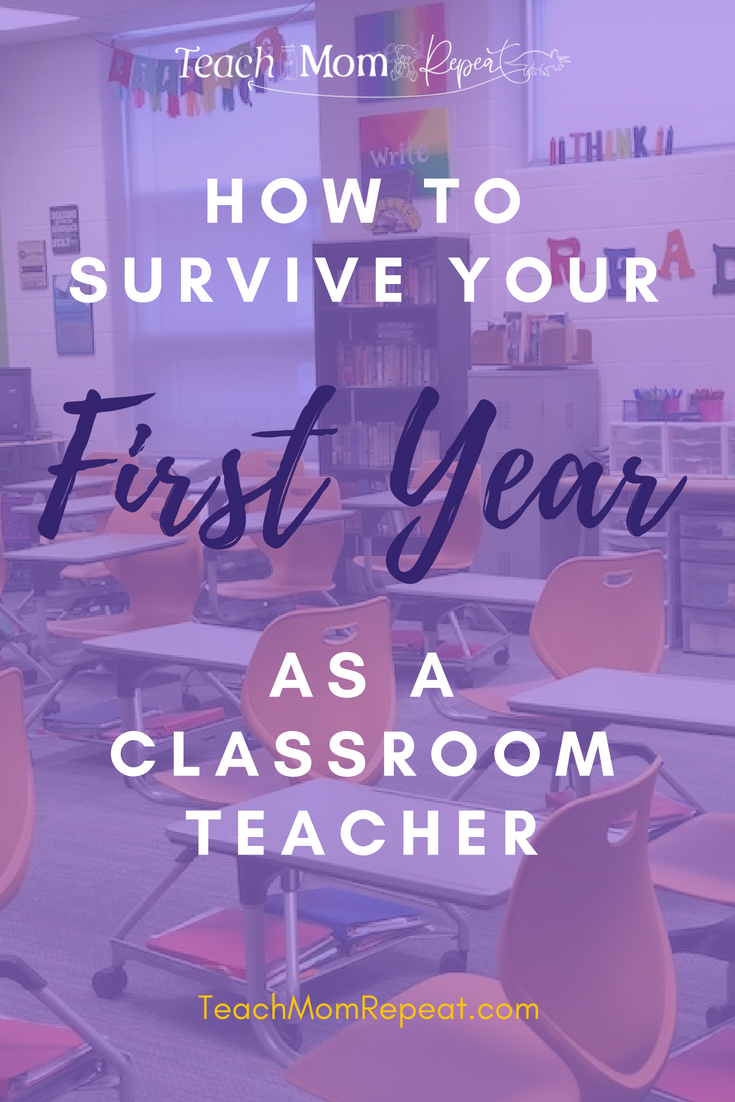
If I could go back in time to tell myself a few things I’ve learned along the way here is what I would want to share:
- Find positive people: Being a teacher is hard work. There always seems to be a lot of work and many situations that we just don’t know how to navigate until they are happening. I’m sure you’ve read all about the teacher’s lounge and the complaining that happens there. Sometimes you will need to vent or talk through a situation without needing to filter because maybe you are a verbal processor. Find someone you can trust to be kind to you, to encourage you. You do not want to find someone who will jump into the pit and make the mud bath deeper. You’ll need to be pulled out of the trench at some point in this first year, and that’s perfectly ok, just be sure you have a friend with a ladder.
- If it doesn’t work admit it and move on: There will be other teachers to support you, give you great ideas, share their best practices. Plus you have all those plans you created in college, right? Yes, and no. Sometimes things look better on paper, or sometimes a person creates a great plan that works for them; it’s ok if it doesn’t work for you. In the world of teaching, we educators understand the meaning of flexibility. Kids are different every year, so what may have worked with one group doesn’t mean it’s going to also work with the next. Don’t waste time on something that isn’t working. Take the time to see what you might be able to tweak, but if that doesn’t help then ditch it and move on to something that will work.
- Beg, borrow and steal: If only social media had been around when I first started teaching! The ideas that are now available are innumerable. Plus, the network of teachers extends well beyond your own district. Talk to the teachers around you to find what works for them, check Pinterest (but don’t get caught up in comparison), start following teacher Instagramers and hashtags (#teachersfollowteachers). You will find what works for you and your class of kids. It may take a few trials, but it will happen.
- DO NOT COMPARE YOURSELF TO VETERAN TEACHERS: We have been at this for a very long time, some of us, and it’s taken that long to actually get there. You don’t graduate college knowing all the things we now know. It took the experience with certain kids and families. It took professional development, or new research and lots of trial and error to make our classrooms run smoothly. You’re coming in with a whole lot of head knowledge, so be sure to soak up the heart knowledge that will help build your career for years to come.
- Finally, don’t try to do it all: Several years into my career I decided Saturdays belonged to me. Since I was single for most of my career I would think nothing of spending time in the classroom grading papers or making new lessons all weekend long. That didn’t make for a very happy social life, and it most certainly did not give me balance. Find your balance! Your career does not define who you are, especially when you serve so many roles in life. Don’t forget to be the other important parts.
This advice is probably great for all of us to be reminded of as the new school year approaches. With high-stakes testing at our heels, it can be a daunting task to feel successful. Remember that we teach kids, not subjects.
What first-year advice do you wish you could have told yourself back then? First-year teachers, share what advice you hear the most, or what’s the most unique tidbit a teacher has shared?

by Carly Black | Jun 27, 2017 | Classroom Solutions, Teacher Solutions
Teaching is a calling. This is something I firmly believe to be true. Choosing a grade level is also part of that calling. Let me share my journey of teaching and how it came to be that I landed in a middle school classroom.
When your grandmother is an English teacher and your aunt owns a used bookstore it’s common to receive a book as a gift. It’s also common that children exposed to books at such an early age will become life-long readers. My love of books was inevitable. Writing became a passion after my very first narrative assignment. My red crayon told a story about spending the day with a kindergartener. From there I kept diaries and journals in my free time. Experimenting with narratives and even a little poetry. It wasn’t until high school that I finally heard some constructive feedback. I still remember the moment I looked at that large red C float atop my title. I was devastated, but Mrs. Harpster taught me more than any other teacher.

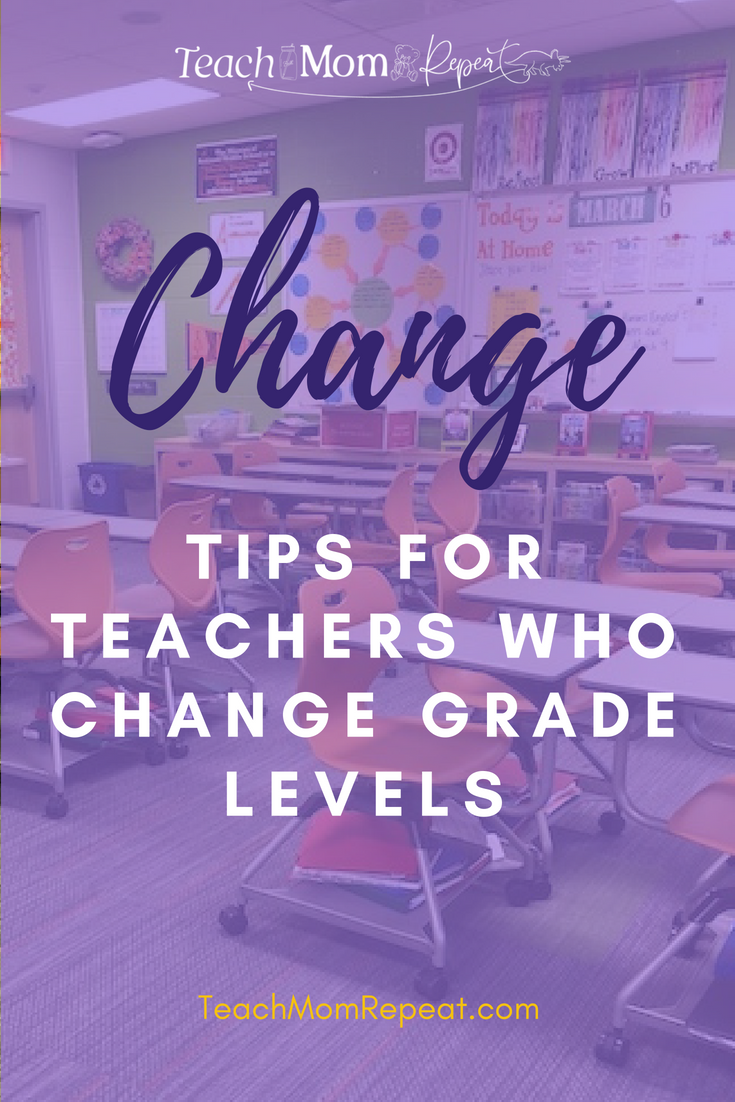
Some of the links found in this post are affiliates. This means if you make a purchase after clicking through we will receive a small compensation at no extra cost to you. Thank you in advance for your support and please know that we only endorse products we use and love.
I learned that her daughter was a journalist and this soon became my passion. Journalism and spending ALL my time in her classroom. In my senior year, Mrs. Harpster agreed to have me as a teacher’s aide. She also asked me to teach a few lessons to her lower level freshman class while they were reading Romeo and Juliet. I scheduled to be part of her very small senior Shakespeare class that year as well. Watching those freshmen, who mostly hated books, read with enthusiasm brought me so much joy. Teaching became my new passion and collegiate ambition.
I learned quickly that following in my elementary teaching mother’s footsteps was not for me. High school was much more appealing until I completed my student teaching. Landing in middle school happened thanks to a small group of 7th-grade girls. One of my last college experiences required that I work with a small reading group. It was the most exhilarating experience! Similar to the one I had in high school, but this time it was all me.
At first, they were all very shy about participating; by the end, they all had grown in ability. All 5 of the girls were willing to read and share out loud. That’s when I decided I wanted middle school and not high school. I’m so glad I made this decision. As it turns out the majority of my career has been spent in 7th grade.
Seventh graders are the middle child of our middle school. I always say that in 7th grade they aren’t the kids they used to be, wanting to still play with Barbie and G.I. Joes, but they also aren’t the young adults they will become eventually. It’s always an awkward year. So when my principal asked if I might be willing to change grade levels I was a little hesitant. However, it’s been several years at one grade level so I’m ready to make a change.
Advantages of moving up with students
The first thing that occurred to me was that I will have some of my same students again next year. This could really work to my advantage. Many of the kids will already know my classroom systems: turning in papers, checking in/out classroom library books, absent work, and general classroom procedures. I can use this knowledge to empower them as leaders in the room, regardless of their academic abilities. I can see this being a great confidence booster for many of my former students.
I started by allowing former students to brainstorm all the things students who are new to the classroom might need to know. I wanted to give them this opportunity in case they thought of something I had not. Their list mostly matched mine, but it helped to have students as teachers right from the start. It set a tone of community where students help each other. They covered topics like checking books in and out of our classroom library, where community supplies are located, where to turn in assignments, and how to participate in the 40 book challenge. They also took less time than I usually would because they were to the point. I now realize how much extra information I provide that’s not necessary.
The other great advantage of looping with students is starting with an established relationship. I know these kids, but I also know some of them will do some maturing over the summer. I want to be sure I’m giving them a chance to show me who they are in the current school year, and not treat them as they were the previous year. This is a great opportunity to start the year with a few growth mindset activities. I am able to share my own process of growth over the summer and make growth mindset a foundational conversation. We read Rosie Revere, Engineer to focus our discussion on mistake making and what opportunities they will have in class to fix mistakes.
Physically moving a classroom
The only real disadvantage has been moving my classroom again. Our current building is now only two years old, so I made a big move recently. Even though I purged a ton of things in that move, I still found plenty of things to purge in this year’s move also. It’s amazing what we accumulate as teachers.
I have big shoes to fill, as I’m replacing a retired teacher, but I’m feeling up for the challenge. I’m looking forward to new teammates and the new dynamic of teaching kids one step away from high school. Have you ever made a grade change? What did you find to be the most helpful tool in making a successful transition?

by Carly Black | Jun 11, 2017 | Classroom Solutions, Teacher Solutions, Teaching Methods
Co-teaching can be stress-inducing or stress relieving. How YOU choose to approach it will make all the difference. Many teachers treat their classrooms in the same way a dog would treat his backyard. We set it up just the way we like it, keeping all the important pieces in an organized system that is often only understood by the creator. So when someone steps onto our turf we can be a little possessive. When it comes to co-teaching this mindset will not be productive.

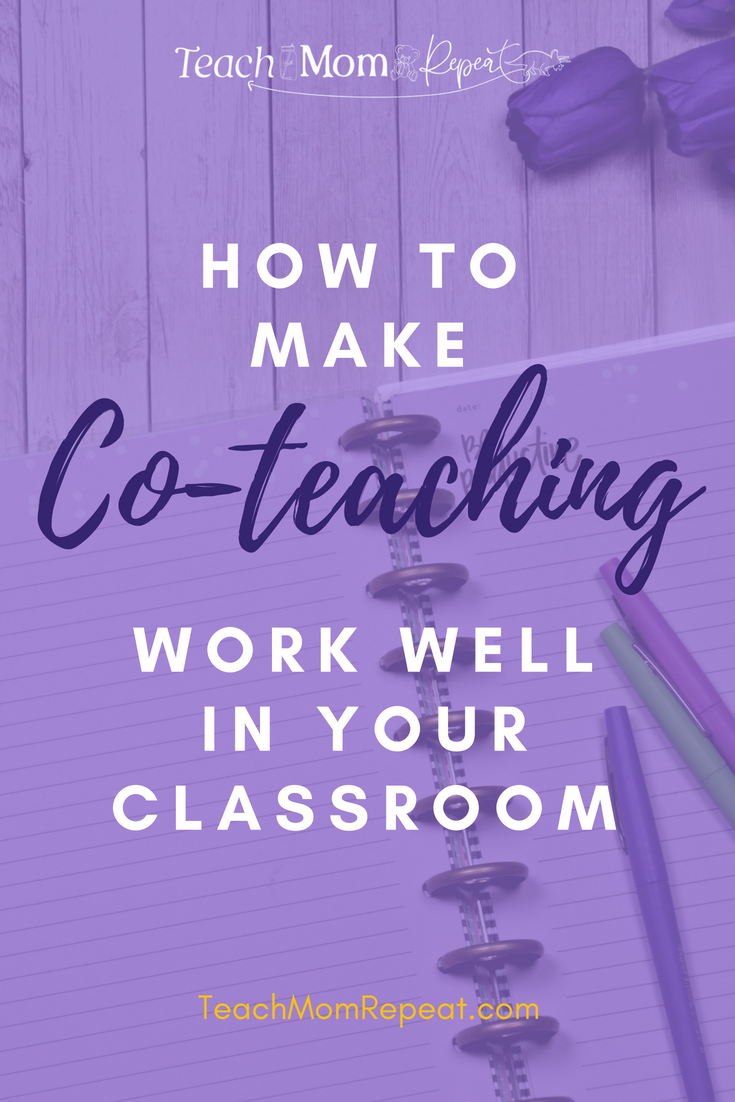
In my second year of teaching, they scheduled me with a co-teacher. I was already feeling very green as an educator, and to have another teacher in my classroom every day who would judge my teaching only made those insecurities flare. However, this was not the actual experience. My co-teacher never treated me in a way that made me feel like I didn’t know what I was doing. The truth was I didn’t always know what I was doing. She was good at helping me find ways to help all the students in our class. She became a teacher to me, as well, that year. Thankfully that first experience helped me to keep an open mind about the co-teaching model.
Ways to make co-teaching run smoothly
It was a decade before I would see another co-teaching experience in my classroom. Not that this was my choice, it just didn’t work out for me to be scheduled with one. Co-teaching is now a regularly scheduled course for me. When this change was made I wasn’t aware of who my co-teacher would be until those first work days before students arrived. This is not an ideal situation. If it’s possible to have more than a few days to coordinate I suggest taking the time to do so. This can really save a lot of time later.
When meeting your new partner it’s best, to be honest about your feelings or past experiences with this model of teaching. If you’ve had a negative experience previously be upfront about it. However, keep in mind this is not the same person you once worked with so don’t punish them for someone else’s crimes. Start the conversation by sharing your philosophy and systems used in the classroom. Then give them an opportunity to critique those ideas with a special educator’s lens. The systems I’ve put in place work for me, they were created by me and I get them, this is not always the case for students. I need to be flexible in the way I organize. A student’s main deficiency might overlap with a way I’ve decided to organize. There can still be an organized system, it may just need some tweaks for the students we serve.
Ideas for co-teaching lessons
Next comes the actual teaching part. This school year I noticed my co-teacher watch me a lot. At first, I was self-conscience, but then I realized she was just getting to know my style. We frequently checked in with each other as the lessons played out or during small breaks while students worked independently. It soon became a rhythm we were both beating. Co-teaching can take a few years to really feel comfortable with someone, but that’s the nature of education. Teaching, in general, takes trial and error to see what really works well. My co-teacher and I are always finding ways to revamp our lessons, but the key to making it work is honesty.
Honesty is always going to be the best policy when working with someone in such close proximity. It’s best to be direct in a loving manner. My co-teacher and I are both direct kind of people and this saves us a lot of time and frustration. None of us have the superpower to read minds (in a middle school classroom the thought makes me shudder) so be aware of the expectations you may have placed on your partner without their knowledge. If something seems to be off, openly discuss it. Your productivity and relationship will thank you.
Throughout the next school year, I hope to share some of the strategies that work best for our team. One idea that we have decided to try out for the school year is Guided Reading. We are also testing the idea of eliminating the whole class novel. Our district brought in co-teaching guru Sonya Kunkel, who has been very helpful in giving us some very real advice, as well as, lesson ideas. Leave a comment and share how you are working well with your co-teacher.
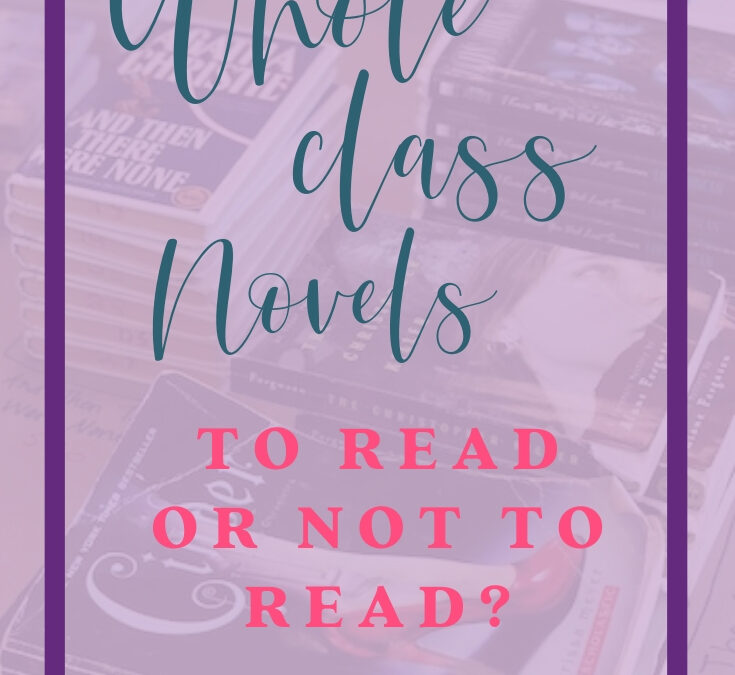
by Carly Black | Jun 1, 2017 | Classroom Solutions, Teacher Solutions, Teaching Methods
In the 15 years, I’ve been teaching so much has changed about how we teach kids to read and write. Many things have been the same since I left college, but how we teach books has definitely changed. Last summer I spent my sleepless nights feeding our newborn and reading all I could on teaching reading. I’ll admit when a colleague, much younger than myself, dropped the “I don’t teach whole class novels” bomb, I was flabbergasted. Wait? How can you get away with not teaching everyone the same book? Of course, Nancy Atwell has been saying this for years, but I didn’t personally know a teacher who listened to Atwell’s advice. Plus, this was not what I learned in college, which prepared me to be a great teacher. (I hope you just laughed with me!) Yes, college gave me a lot of head knowledge to do my job, but teaching is something that needs to be experienced. This is why they ask us to student teach. Figuring out how to organize every detail that needs to be addressed in the small amount of time you are spending with students per day takes a lot of practice. Then they throw a wrench in the system and change it all up on you. Atwell’s system has a lot of details to work out, and as hard as I’ve tried, the workshop model has been difficult to tackle.

Ohio is three years into the transition to Common Core standards. We have always had standards to teach and methods for which to teach these standards, but times have changed and research is shedding new light. The focus used to be teaching the book to kids. It was all about the book. The focus has now shifted, it’s all about the kid. Teach the kid how to read the book, any book actually. This makes so much more sense! Now I get why we don’t have to teach the same book to every kid. It’s about the skill of reading, not the experience of the book.
Every kid who says, “I don’t like to read,” will hear my standard response, “You just haven’t read your favorite book, yet.” I’ve actually said this to a few adults as well because it’s true. When you find that one book that really grabs hold of you, suddenly reading doesn’t seem so boring, or useless. For kids in middle school who have trouble reading have an even harder time finding their favorite book. Think about a student in middle school, they are probably 12 to 13 years old, much more interested in what their friends have to say, and usually, care a whole lot about their image. With this in mind consider the books they would have to choose from if they could only read at a third-grade level. Most of those options have main characters who are third graders. Most of the book covers make this very obvious. If you were a middle schooler would you want to carry around a book that most of your friends would identify as a “kid” book? Probably not, and here begins the vicious cycle of kids choosing not to practice their reading to become better readers. If they can’t read well, they won’t have books to read that they can truly enjoy, so they continue to hate reading, and never getting any better. Unless we step in as their teacher and teach them how to be better readers. The focus must shift to the kids and away from the book.
Next school year I plan to keep my whole class anchor or mentor texts to short stories or nonfiction. I’ve been converted. What do you think, is there still a place for whole class novels? Or should teachers let go of this traditional method?



